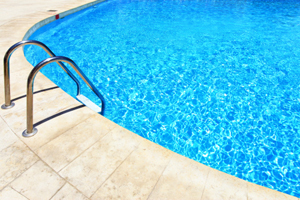How to Use a Pool Test Kit
April 01, 2024

 Lifeguards, facility managers, and homeowners monitor various chemical levels of pool water to prevent unsafe swimming conditions. Chemical levels that are too high or too low will either harm swimmers' skin and eyes, or create unsanitary conditions that allow bacterial growth in the water. The most common tests check pH and chlorine, while more advanced ones provide results for alkalinity, bromine, dissolved solids, and more. Pool water at major facilities should be tested daily. Smaller pools or home pools can be tested a couple of times per week.
Lifeguards, facility managers, and homeowners monitor various chemical levels of pool water to prevent unsafe swimming conditions. Chemical levels that are too high or too low will either harm swimmers' skin and eyes, or create unsanitary conditions that allow bacterial growth in the water. The most common tests check pH and chlorine, while more advanced ones provide results for alkalinity, bromine, dissolved solids, and more. Pool water at major facilities should be tested daily. Smaller pools or home pools can be tested a couple of times per week.
Ideal Chemical Levels
Ideal chemical levels are the same for a private backyard pools or large aquatic facilities. The numbers below are typical, but your own pool test kit may include slightly different ranges or amounts.
- pH: 7.2 - 7.8.
- Chlorine: 1.0 - 2.0 ppm (parts-per-million).
- Bromine: 3.0 - 6.0 ppm.
- Total alkalinity: 80 - 120 ppm.
- Calcium hardness: 180 - 220 ppm, though some say 200 - 400.
- Cyanuric acid: 40 - 80 ppm.
- Total dissolved solids: Below 5000 ppm.
Pool Test Kit Reagents
Reagents are small amounts of chemical solutions that — when mixed with pool water — make it change color. This color is compared to a color scale that corresponds to a specific level of chemicals in the water.
- Reagents come in small bottles that allow you to easily add a certain number of drops to their water samples.
- Refills are available — you should not have to buy an entirely new test kit to replace reagents. Reagents do expire! Their lifespan is typically one season. Temperature extremes and direct sunlight will degrade them faster.
- Liquid reagents have been shown to provide more accurate test results than strips or dip sticks.
Steps for Using Pool Test Chemicals
Since the steps and amounts required vary from kit to kit, always follow the instructions in your test kit. Your kit will either come with a booklet, or have instructions printed inside the lid.
- Take a sample of the water from at least 18 inches below the surface to avoid testing any surface material.
- Add specific amounts (according to the instructions) of reagent or indicator solution to your water sample.
- Shake the test tube to thoroughly mix the reagent and the water sample. When shaking the sample and the reagent, make sure the cap is on. Using your hand to cover the top of the test tube can affect the reading.
- After the water turns a certain shade of red or yellow (depending on your kit), you can compare the color to that on the testing chart and gauge the level of chemicals in the water.
Pool Test Kit Tips
Regularly testing chemical levels is a good way to prevent unsafe pool conditions. Over time, you will get used to the process and it will take just minutes to complete each test. Here are some general tips that will make your testing experience smoother and more accurate:
- A new water sample must be used for each test.
- After each test, the water sample and the reagent can simply be poured back into the pool.
- Different tests will have different reagent amounts and different color results. Every test kit is slightly different. Be sure to read the instructions that come along with yours!
- Use a logbook to record the pool's chemical levels each time you test. This will help you keep track of chemical levels over time and can come in handy if professionals pool maintenance workers need past pool data.



